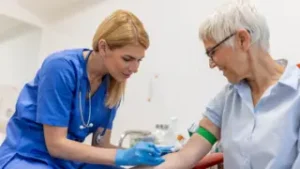‘Lungs in a box’ could increase vital transplants
The number of lung of transplants could rise as a new machine keeps organs alive outside the body.

 Royal Papworth Hospital
Royal Papworth HospitalA new machine which keeps lungs alive outside of the body could “transform” the number of people receiving transplants, surgeons hope.
The breakthrough has come at Royal Papworth Hospital in Cambridgeshire after it became the first in the UK to pilot the use of the XPS system.
The machine, nicknamed “lungs in a box”, mimics the human body and surgeon Marius Burman said it could increase the number of transplants by 30%.
Daniel Evans-Smith, a 49-year-old event manager from Northampton, was the first to receive a double lung transplant using the system on the NHS and said he was “immensely grateful”.
 Royal Papworth Hospital
Royal Papworth HospitalSome 81% of lungs are rejected for transplantation because they are inflamed or in poor condition.
The machine improves the health of the organs, by using a ventilator to inflate and deflate the lungs. A liquid containing nutrients and oxygen is also pumped through them.
The technique is called ex vivo lung perfusion (EVLP). It means donated lungs which are considered “borderline” for use can be reconditioned and used, instead of being discarded.
The organs are kept at body temperature, for up to six hours.
The one-year pilot has been funded by NHS England and the Royal Papworth charity.
The machine was only previously used in UK research trials.
 Royal Papworth Hospital
Royal Papworth HospitalProf Derek Manas, NHS blood and transplant medical director, said there was “mounting evidence” the technology could “enable more transplants by improving organ function”.
Despite the law change on organ donation consent in 2019, the hospital said there was a shortage of donated lungs, so the machine was making the most of those available.
Prof Manas said more than 200 people were waiting for a lung transplant which “significantly” outweighed the number of suitable donor organs.
Having the lungs “alive” outside the body also allows surgeons to test the organs, which means the transplants have a better chance of success.
 Royal Papworth Hospital
Royal Papworth HospitalMr Evans-Smith quit smoking 12 years ago, but developed chronic obstructive pulmonary disease (COPD), a lung condition that causes breathing difficulties.
He suffered a collapsed lung on five occasions and spent a total of six months in hospital before the transplant.
He was about to be discharged when he was woken by nurses who told him donor lungs had been found.
The organs were put on ice and transported to Cambridge, where they were placed in the machine to be “reconditioned” before transplant.
 DAWID WOJTOWICZ/BBC
DAWID WOJTOWICZ/BBCMr Evans-Smith said it was a “privilege to be chosen”.
He said: “There were conversations this time last year, with some of the hospitals saying I needed to talk about palliative care, because if I didn’t get the transplant under way very soon, the likelihood was I wouldn’t survive.”
He is now hoping to fundraise for the team that saved his life.
“I can now do hills without having to think about it, I don’t have to rest when I’m out and about around town,” he said. “I can’t thank them enough”.
 NIKKI FOX/BBC
NIKKI FOX/BBCMarius Berman, surgical lead for transplantation at Royal Papworth Hospital, said they were “very proud to have become the first UK hospital to use this machine” outside of clinical trials.
Other technology exists, but surgeons said the simplicity of the machine allows people to be trained quickly and some alternatives require a surgical team to travel to the donor, which can be expensive.
He said 30% of people on the lung transplant list died and Mr Evans-Smith had “had a very small window of opportunity”.
“Daniel would not have been with us today without a lung transplant, and we couldn’t have done the lung transplant without EVLP,” he added.
Royal Papworth hospital carries out more lung transplants than any other UK centre, completing 41 in the last year.







